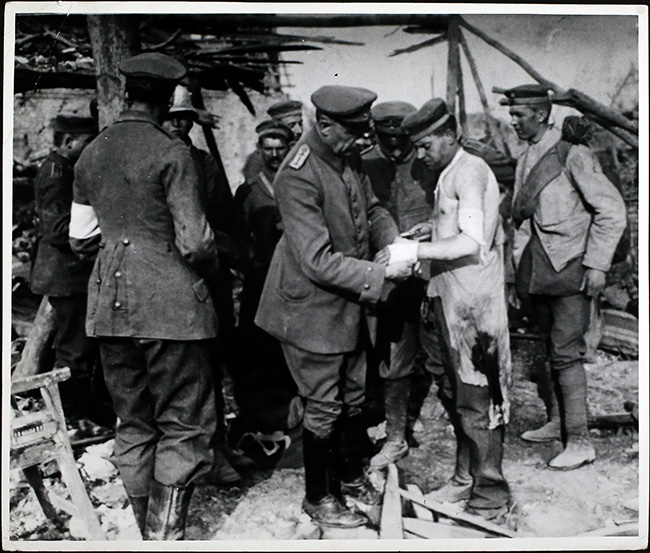Here’s how successful the first 3 days of the First Battle of the Scarpe were for the Commonwealth Forces: the advances were the deepest of the war so far, up to 3 ½ miles deep in certain regions of the Front, yet the casualties numbered just 13,000. According to Mark Adkin’s ‘The Western Front Companion’, that is just 25% of the number of casualties sustained on the first day of the Somme Offensive alone. The gains from the latter campaign? A paltry 5 miles in just over 4 months of extremely fierce combat. So, why were the numbers so different in this battle?
For a start, the generals had taken some valuable lessons from the mistakes made the previous year. In a previous blog we summarised the main problems, including attacking head-on, unprotected, in broad daylight with already tired troops, over-estimating the effects of the artillery barrage on a well-manned enemy stronghold, and failing to exploit weaknesses in the enemy line with adequate reserve troops.
This time, the attack was far more co-ordinated and protected. It was made over a Front almost 2,000 metres wide, so that there was no one narrow gauntlet of fire for the men to face, and each attacking battalion had another lined up behind it for support (ready to storm ahead once the first 2 of 3 objectives had been achieved). The advance of the infantry was aided not only by a heavy preliminary barrage, as in the Somme, but also a creeping one (i.e. a series of explosions timed to travel slightly ahead of the troops). This served the dual purpose of providing protection from enemy fire and clearing the path ahead of any defenders and artillery. A quarter of the explosives were set to release smoke as well, for further shelter. The commanders, thanks to a combination of experience and aerial reconnaissance, had more of an idea of what they were letting themselves in for, so were better able to plan an effective attack. What’s more, they got lucky. Far from being on the spot and waiting behind their machine guns, as in the Somme, many of the German reserves in Arras were waiting well behind the Front Line, and could not be brought forward in time.
Then again, the Germans’ lack of preparation may not have been all luck, but partly due to the efficiency of the Commonwealth planning. The soil in the Arras region was very chalky, and the British tunnelling companies had been working since October the previous year to dig a network of tunnels connecting the reserve trenches with the Front Line. Thanks to these, troops could be moved in ready for battle without being spotted by the Germans. Other preparations put in place were extensive air reconnaissance, adequate air support to neutralise the German aircraft, trench raids ahead of the attack, allowing the Commonwealth troops to gain valuable intelligence regarding enemy supplies and tactics, and extensive training in following a creeping barrage efficiently.
The attack, by both the mixed British and South African divisions and Canadian troops, went off virtually without a hitch. At dawn on 9th April 1917 4 divisions of the First Army Canadian Corps, backed by 1 British division and led by Lieutenant General Sir Julian Byng, stormed the key observation point on the Plains of Douai. Their aim, in taking over the ridge, was to protect the southern flank of the Arras advance from enemy fire. They bombarded the Germans for a week prior to attacking, then the infantry carefully followed the creeping barrage, the reserve units ready behind the lead divisions. As they advanced, they detonated bombs dug into the soft ground below the enemy lines. It took just 2 hours for all but 1 division, which was briefly held up by machine gun fire, to reach their goals. By the end of the battle they had sustained just over 10,000 casualties, according to ‘The Western Front Companion’, and taken 4,000 prisoners from the Sixth Army I Bavarian Corps. In the process, they earned 4 Victoria Crosses.
Meanwhile, the British and South African troops were making their own advances. From the British First and Third Armies, 14 divisions lined up to fight over a 10 mile front, 2 miles deep, facing the 14th Bavarian Division. Their bombardment started just 5 days early, and they aimed to press forward to the Hyderabad Redoubt, capturing the towns of St Laurent and Athies while they were at it. Like the Canadians, they advanced behind a creeping barrage. At first certain Brigades took the lead, then after the first objective was reached the reserve divisions took their place. After both towns were won, the 9th (Scottish) Division slowed while the 4th Division overtook, and pressed on to the Redoubt. This meant fresh troops were always up front, and the attack kept its momentum. A total of 7500 prisoners and 36 guns had been taken by the end of the first day alone.
The only slight hitch in the whole advance had been the lack of success by the preliminary barrage in dealing with the vicious rolls of protective barbed wire; luckily, thanks to the scarcity of German defenders, the troops were able to search out and make use of the routes the Germans took to return to their trenches. If the positions had been well-manned, the battle might have gone differently. There were also not enough reserves held back to really make a lasting, clean break through the German lines; perhaps each row of troops could have been worked for slightly longer to preserve the energy of those behind, or even more men brought in. After the impressive first 3 days, the advances slowed considerably.
Still, there is no doubt that the battle had proved the effectiveness of careful multi-force planning and advancing behind a creeping barrage, so it is generally seen as one of the most exemplary offences of the Great War.


